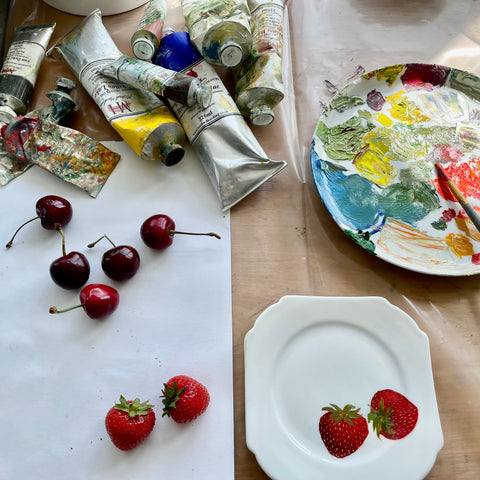News — pictures on plates
Having a Tea Party
Tea Party Exhibition at Utopia
9 Fish Hill, Holt NR25 6BD
The Tea Party exhibition is a celebration of artworks inspired by the English tradition of taking afternoon tea. Expect humour and surprise as each artist reveals their unique and delightful response in clay, textile and paint.

Exhibitors are: ceramicists Remon Jephcott, Ian Rylatt, Eluned Glyn, Alvin Irving, Katherine Kingdon and textile artist Fran Squires plus a collection of new oil paintings by Jac Scott.
Eluned Glyn
Eluned Glyn is a ceramic designer/maker, living and working in Cardiff, Wales. She exhibits widely around the UK and Europe. Her fine art background and interest in Cubism has led to her Minimus Maximus Collection.

Pieces are created by using broken crockery to make faceted objects, which are cast in pottery plaster and then slip-cast in earthenware clay. The ghost-like simplicity of the collection reflects the redundancy of colour that are typically absent in modernist design. It is the marriage of form and function that intrigues her and the distortion of the domestic object which is familiar, yet foreign in form.

Remon Jephcott
The traditional afternoon tea, as popularised by Victorian women, provided a setting for intimate social engagement. Inspired by this ritual, Remon Jephcott finds that the teacup is imbued with femininity, revealing a relationship between gender and object: characteristics such as delicacy and fragility with a precious quality.
The respectability that was a moral necessity for Victorian women, was not always upheld within their society, which Remon has subtly referenced in her teacups.
Remon Jephcott has a ceramics studio in Truro, Cornwall where she creates her earthenware clay sculptures using crackle and barium glazes to echo age and decay followed by decals and lustre firings.

Ian Rylatt
Ian Rylatt is a ceramicist with a finely tuned sense of mathematical proportion and sculptural balance. His fascination with abstracting and manipulating the teapot form has won him national acclaim.
In 1988 Ian became a studio potter in Lincoln, moving onto Wales in 2004 where he has an established practice. Since 2010 he has been a member of the Makers Guild of Wales.

He hand throws and constructs his pots in stoneware, then fires them at 1260°- 80°c. He uses bespoke black/rust glazes including colouring oxides manganese and iron to create his distinctive style of ceramics.

Fran Squires
Fran Squires is an East Anglian storyteller who uses textiles, print making, drawing and salvaged remnants to tell her narratives. She works in a very organic way letting the stories unfold in a loose graphic style with painterly details. Drawn to patterns in the world around her, she transposes these into pictorial artworks that attract the eye and pique curiosity.


After studying Surface Pattern at university, she went on to work as a designer, then technician at Norwich University of the Arts. Fran is now a full-time artist devoting her time to exploring new ways to tell her stories.
Katherine Kingdon
Berkshire based ceramicist, Katherine Kingdon, tells stories in clay. Her pieces are imbued with humour and her surface imagery playfully pokes at your imagination.
"I like the way that form and surface speak of place and circumstance, how something simple and mundane has the power to evoke memories or spark the imagination and take our mind for a walk."

Katherine slab-builds each piece, then sets about populating the surface with finely rolled slivers of clay. She invents these into characters and stories, leaving an element of ambiguity for the viewer to play with.

Alvin F. Irving
Cumbrian based Alvin F. Irving creates statement ceramic teapots to use as a canvas for his pictorial narratives. He throws and constructs tableware in porcelain and white earthenware. The pieces are then painted with underglaze brushwork and gold lustre highlights.

Home Collection
New oil paintings by Jac Scott

The domestic space has long held a fascination with many artists. Whatever the medium, to transpose the enigmatic and the mundane of home, is an enduring focus. Often drawing our attention to the small and overlooked elements, these still life works form narratives on our way of living.

Here Scott is preoccupied with the celebration of the joy of home comforts and the reflection of her feelings that these simple objects bring. By painting atmospheric vignettes, she focusses our gaze on a few items that capture the essence of the subject.

Her own country home forms the canvas for this unique collection with her love of old crockery, antique books and flowers emanating throughout the paintings. The casual, contemporary format of the compositions, the painterly style of the brushwork and the saturated colour palette, create an inviting window into the artist's world.

"I want to create pictures that are colour baths to wallow in and to soak up the warmth. The cosy style should feel like a wall-based hug".
Passion on a Plate - original fine art on vintage plates
Plated Collection

I have had a passion for antique white plates for many years and collect reticulated ones - they make a lovely display on the wall with unusual shadows through the holes. My collection is not extensive as good ones are hard to find and those with chips or cracks are not of interest. Displaying them in groups makes a strong statement. So it was this love of old white plates that ignited the idea of collecting interesting vintage white plates. They have to speak to me in some way. Painting original still lifes on them hopefully makes them covetable again.

It's fun to do and I enjoy the immediacy of it. My drawings and paintings take so long to do, whilst the plates are relatively quick - although of course the oil paints still take weeks to dry.

I confess I only paint subjects that interest me and those that seem to 'sit happily on a plate'. That expression is hard to define but see if you agree. Beautiful vegetables and fruits, some picked from my own garden, glistening fish and antique cutlery are first to be captured. These simple still lifes look great on their own or even better in a group. Building a plate-scape is simple as I sell them ready to hang with a brass plated hanger (with protective ends) and a wall fixing, so super quick and easy to attach to your wall. Alternatively, you could place the plate on a special stand. It's fine art on a plate only - don't ever use them for eating or put them in your dishwasher!


Artists throughout history have been drawn to designing plates - strange but true. Even Picasso in the 1940s embraced the art form, creating unique pieces as well a limited edition designs with a local pottery. In the 1970s Julian Schnabel and Judy Chicago famously harnessed the power of the humble plate to send their eloquent messages. But does this question the traditional hierarchy of the art world - is it subverted? How delicious. Does the fine art element diminish - is it of less value because its on a plate - does the association of domesticity devalue it? What do you think?

To find out more about the history of painting on plates click on this link
https://www.artspace.com/magazine/art_101/art_market/artist_designed_tableware-51836
